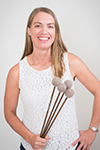by
Rhythm Scene Staff
| Oct 25, 2021
As a reminder, the terminology used in installments of this series on four-mallet keyboard technique were codified in Leigh Howard Stevens’ book Method of Movement. If you haven’t yet read the first five articles, please check back for archived articles in Rhythm! Scene. In this particular article, we’ll be addressing hand, arm, and body positioning relative to the keyboard. Proper posture and positioning are key to performance accuracy and general physical health.
GENERAL BODY POSITIONING
When standing behind the keyboard, the body should be positioned approximately 12 inches away from the bars. When in playing position, the elbows should remain in front of or even with the body. Position yourself in the middle of the range of the passage being played. Make sure your shoulders are relaxed, back, and low, your back is straight both vertically and horizontally, and your neck is loose and straight. Take a deep breath and allow the entire upper body to relax into a comfortable rest position.
WRIST AND ARM POSITION
For all three standard four-mallet grips, it is important that the wrist stays in a neutral position as much as possible. Any vertical or horizonal movement away from this point will create unnecessary tension. The arms should be comfortably bent at the elbow and just slightly wider than a 90-degree angle. A comfortable and relaxed rest position will help maintain proper motion and technique, as well as aiding power and note accuracy and minimizing risk of injury. In addition to positioning yourself carefully in the middle of the range being utilized, take time to adjust the height of your instrument to ensure this relaxed, neutral wrist and arm position.
MOVEMENT
As the notes being struck move, so should the body, so as to keep the performer in front of those notes. Generally, movement of one to two octaves can be accomplished by shifting the body weight one direction or another, while movement greater than two octaves will require the feet to shift as well. A common error is crossing one hand in front of the body when playing ascending and descending passages, kinking the wrist and inhibiting motion. By shifting the weight of the body (smaller motion) or stepping to one side or the other (larger movement), this issue can be easily avoided. In the process of analyzing your stroke motion and pitch accuracy, be sure to also observe body, hand, and arm positioning as well. Utilize simple exercises that move around the keyboard to specifically work on this additional consideration. Remember also to stay at least one foot back from the keyboard, as this will aid in peripheral vision and note accuracy, while allowing for a full range of motion.
NON-HORIZONAL POSITIONING
When it is necessary to place mallets in the same hand on two different manuals, adjust both your arm and body position as needed to keep the wrist position as relaxed and neutral as possible. A root-position D-flat major chord, for example, will require a shift of the body towards the left and a left arm position slightly further from the body, while a D major chord would require a shift of the body to the right and both elbows slightly tighter to the body. The elbows need to push out for a B-flat major chord while the body moves closer to the instrument, but a slight step back and elbows tucked closely into the body are required for a B major chord. It is important in these cases to consider use of the edges of the accidentals to reduce the required angle as well. Be diligent about keeping your shoulders and wrist lows so that the mallets strike the keyboard flat on the mallet’s playing surface, not by the tip.
CONCLUSION
As with any keyboard playing, the position of the hands, arm, and body should serve to make technical requirements easier, not harder. As you play, consider how slight adjustments to any of these might make for a more relaxed and accurate stroke motion.
 Emily Tannert Patterson is a percussionist and online educator in Cambridge, U.K. Previously she was a percussion educator, arranger, clinician, and consultant in the Austin, Texas, area, serving as the percussion director at Rouse High School and Wiley Middle School, in Leander from 2015–18 and at East View High School, Georgetown, Texas from 2011–15. Her ensembles have garnered numerous accolades, including winning the 2016 PAS IPEC. Patterson holds a master's degree in Percussion Performance from the University of Texas at Austin, where she studied with Thomas Burritt and Tony Edwards. Patterson earned her bachelor’s degree in Instrumental Music Studies, along with an undergraduate Performance Certificate in Percussion and her Texas teaching certificate, from UT in 2008, and received her bachelor’s degree in Journalism and Political Science from Northwestern University in 2004. Patterson marched with the Glassmen Drum and Bugle Corps in 2003 and was a member of the 2004 WGI world-champion indoor drumline Music City Mystique. Prior to her move to the U.K., she was active in judging around the country. Patterson holds professional memberships in the Texas Music Educators Association and the Percussive Arts Society and serves on the PAS Education Committee.
Emily Tannert Patterson is a percussionist and online educator in Cambridge, U.K. Previously she was a percussion educator, arranger, clinician, and consultant in the Austin, Texas, area, serving as the percussion director at Rouse High School and Wiley Middle School, in Leander from 2015–18 and at East View High School, Georgetown, Texas from 2011–15. Her ensembles have garnered numerous accolades, including winning the 2016 PAS IPEC. Patterson holds a master's degree in Percussion Performance from the University of Texas at Austin, where she studied with Thomas Burritt and Tony Edwards. Patterson earned her bachelor’s degree in Instrumental Music Studies, along with an undergraduate Performance Certificate in Percussion and her Texas teaching certificate, from UT in 2008, and received her bachelor’s degree in Journalism and Political Science from Northwestern University in 2004. Patterson marched with the Glassmen Drum and Bugle Corps in 2003 and was a member of the 2004 WGI world-champion indoor drumline Music City Mystique. Prior to her move to the U.K., she was active in judging around the country. Patterson holds professional memberships in the Texas Music Educators Association and the Percussive Arts Society and serves on the PAS Education Committee.
 Josh Gottry is a respected educator, accomplished percussionist, and internationally recognized composer who has been working with, and creating music for, the next generation of percussionists for over twenty years. He has served on the music faculty at college and university campuses around the Phoenix metropolitan area, works regularly with ensembles and students at all grade levels as a clinician and within his private lesson studio, and his performance record includes professional orchestras, musical theater, worship teams, jazz combos, community and chamber ensembles, as well as solo performances and recitals. Gottry is an ASCAP award-winning composer whose works have been performed at colleges and universities, junior high and high schools, and multiple national conferences, and he serves as editor for Rhythm! Scene.
Josh Gottry is a respected educator, accomplished percussionist, and internationally recognized composer who has been working with, and creating music for, the next generation of percussionists for over twenty years. He has served on the music faculty at college and university campuses around the Phoenix metropolitan area, works regularly with ensembles and students at all grade levels as a clinician and within his private lesson studio, and his performance record includes professional orchestras, musical theater, worship teams, jazz combos, community and chamber ensembles, as well as solo performances and recitals. Gottry is an ASCAP award-winning composer whose works have been performed at colleges and universities, junior high and high schools, and multiple national conferences, and he serves as editor for Rhythm! Scene.